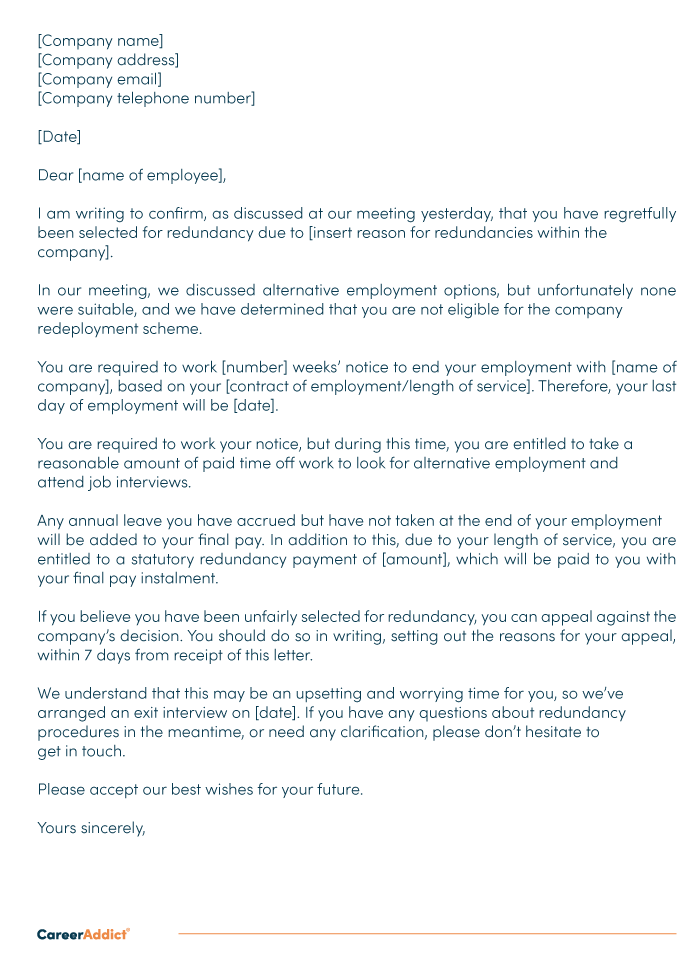What Happens to Redundancy If Company Goes Bust? A Guide to Your Rights
What Happens to Redundancy If Company Goes Bust? A Guide to Your Rights
Blog Article
Checking Out the Interplay Between Firm Redundancy and Business Adaptability for Future Development
In the vibrant landscape of today's service globe, the detailed connection in between business redundancy and business flexibility emerges as an essential variable for sustained development and success. Firms typically deal with the difficulty of striking a fragile equilibrium in between maintaining a level of redundancy to reduce dangers and promoting versatility to react swiftly to the ever-evolving market demands.
Relevance of Firm Redundancy
Company redundancy is a critical aspect that boosts business resilience and alleviates operational dangers. By integrating redundancy procedures within the organizational structure, business can better endure unpredicted disturbances and changes in the organization setting. Redundancy functions as a calculated buffer, enabling companies to adapt and react properly to unforeseen difficulties without jeopardizing vital operations.
One key aspect of the value of firm redundancy is its duty in making sure continuity during times of situation. When confronted with unexpected changes or emergencies, repetitive systems, resources, or employees can action in to preserve essential features and avoid widespread disturbances. This connection not only safeguards the company's reputation and consumer depend on however likewise reduces financial losses and functional downtime.

Techniques for Organizational Versatility

One more crucial technique is purchasing modern technology and infrastructure that can support versatility and scalability. Carrying out electronic devices, automation, and information analytics can enhance operations, enhance performance, and supply valuable insights for informed decision-making. Furthermore, creating adaptable organizational structures that enable quick adjustments to market dynamics and customer needs is important for staying competitive in a swiftly advancing setting. By proactively identifying potential disruptions and opportunities, organizations can proactively adjust and grow in an ever-changing service landscape.
Harmonizing Redundancy and Adaptability
Attaining a harmonious equilibrium in between operational redundancy and business versatility is critical in browsing the complexities of a vibrant company environment. Redundancy within a firm offers a safeguard, making sure continuity and security in operations. Nevertheless, an excess of redundancy can cause inefficiencies and impede versatility to changing market problems. On the other hand, business adaptability allows firms to react promptly to exterior interruptions and seize brand-new opportunities. Striking the ideal balance between redundancy and flexibility is a delicate process that calls for a deep understanding of the organization's goals, sector dynamics, and danger resistance.
To achieve this balance, companies need to conduct normal analyses of their procedures to recognize locations where redundancy is necessary for risk mitigation and where adaptability can drive development and growth. Implementing flexible frameworks, cultivating a society of constant knowing and enhancement, and motivating open communication across all levels of the organization are key methods to balance redundancy and versatility successfully. By lining up these two important aspects, companies can place themselves for lasting growth and success in an ever-changing business landscape.
Study on Adaptation Success
In taking a look at instances of effective business adjustment, it becomes obvious that the interaction in between operational redundancy and flexibility is a defining element in forming durable companies. One engaging study is that of Netflix. At first a DVD rental solution, Netflix demonstrated amazing adaptability by transitioning right into Read More Here a streaming platform when digitalization interfered with the market. By strategically purchasing modern technology and content production, Netflix not only endured but grew in a swiftly developing market. An additional standout example is Amazon. Beginning as an on the internet bookstore, Amazon continually adjusted its business version, increasing into varied sectors such as cloud computing and expert system. This versatility permitted Amazon to remain ahead of competitors and fulfill altering consumer needs. Lastly, Adobe supplies a noteworthy illustration of successful adjustment. The company shifted from selling software program licenses to a subscription-based model, guaranteeing recurring earnings streams and enhanced client interaction. These case research studies emphasize the value of operational redundancy coupled with organizational adaptability in promoting lasting development and competition.
Building Resilience for Future Growth
Building resilience for future growth calls for a critical placement of functional processes with market dynamics and arising fads. Companies need to adjust to changing settings by promoting a culture of flexibility, technology, and continual enhancement. Resilience involves not just recuperating from problems but likewise proactively getting ready for future difficulties. One vital facet of building strength is spending in robust threat administration techniques to mitigate possible interruptions. This includes circumstance planning, diversifying supply chains, and establishing contingency prepare for different backups (who pays redundancy money).
Furthermore, cultivating strong connections with stakeholders, such as consumers, workers, distributors, and the community, is crucial for maintaining and weathering uncertainties count on and assistance throughout rough times. Efficient interaction and transparency play a crucial duty in building durability, as they assist straighten expectations and help with partnership Click Here in browsing unpredictabilities.
Additionally, companies require to focus on learning and advancement efforts to upskill staff members and equip them with the necessary devices to adapt to transforming circumstances. By purchasing their workforce, business can enhance their versatility her explanation and agility, ultimately enhancing their durability for lasting future development.
Conclusion

In the dynamic landscape of today's company globe, the intricate connection between company redundancy and business flexibility emerges as a critical element for continual development and success. Companies typically encounter the obstacle of striking a delicate balance in between keeping a degree of redundancy to mitigate risks and promoting flexibility to respond quickly to the ever-evolving market demands.To accomplish this equilibrium, firms require to conduct regular evaluations of their operations to determine areas where redundancy is needed for threat reduction and where flexibility can drive development and growth.In final thought, the interplay between business redundancy and organizational versatility is critical for future development. Structure strength via a mix of redundancy and flexibility will certainly make certain that firms are prepared for the obstacles of the future.
Report this page